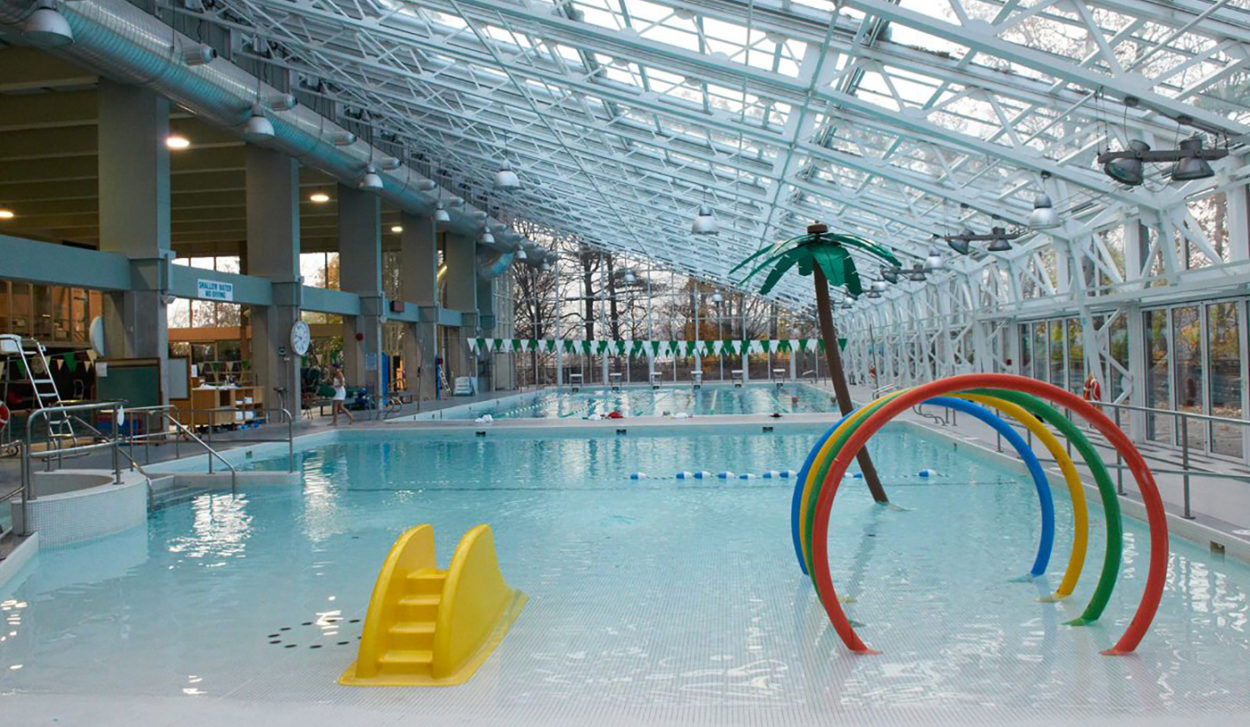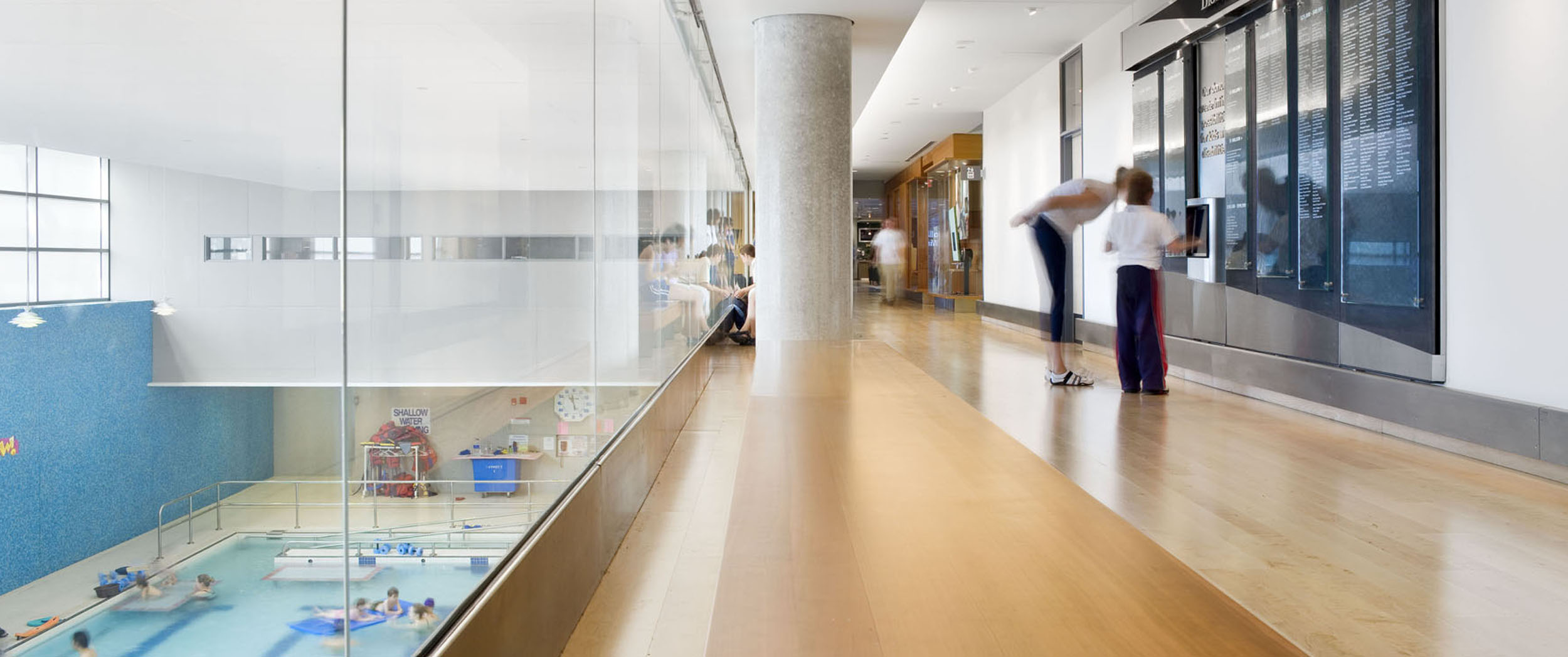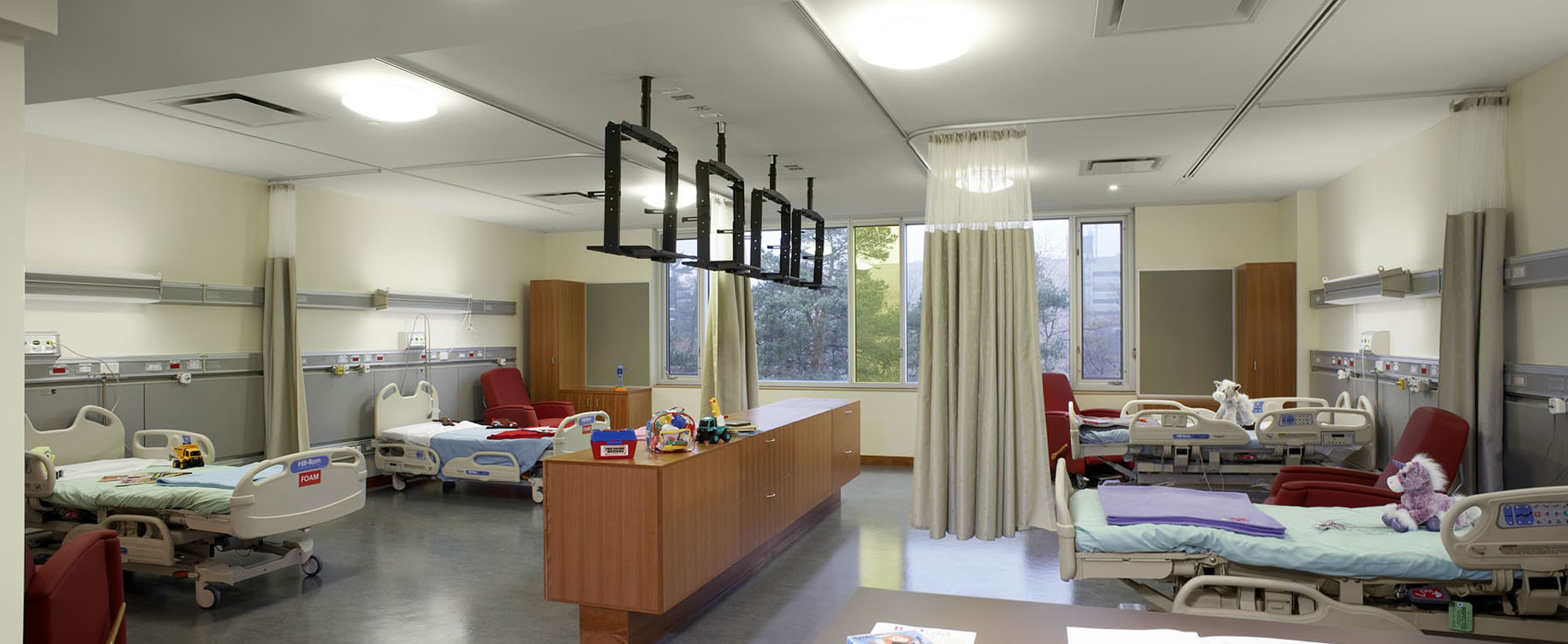Service: Electrical Engineering
The Granite Club
Aquatics Complex
The fourth Granite Club opened in 1972 on a beautiful twenty-two acre site on Bayview Avenue, bordering Toronto’s Don Valley. HH Angus was an integral part of the design and construction team for this premier facility, which provides members with one of the most complete and well-equipped athletic facilities in Canada.
HH Angus is privileged to enjoy a 40-plus-year relationship with the Granite Club and has been involved with many upgrades to the 80,000 ft2 structure since it opened.
The mechanical, electrical and lighting design for the Aquatic Complex renovation included features such as a competition-scale swimming pool, training pool, whirlpool, and children’s pool with water features. Design of the addition also addressed the retractable roof and retractable perimeter walls.
The retractable roof posed a challenge for our lighting design team, who had to identify the location of the fixed structural members and incorporate the appropriate lighting design to address the sloped roof. The solution was the selection of luminaires and supporting details on the fixed structural members of the roof construction, accommodating the retractable roof elements.
HH Angus has also designed upgrades to seven squash courts, four badminton courts, eight curling rinks and separate skating rink, bowling alley, outdoor lawn bowling area, six tennis courts, and a fitness centre.
SERVICES
Mechanical Engineering | Electrical Engineering | Lighting Design
PROJECT FEATURES
Size: 80,000 ft2 | Status: Completed 2008
LOCATION
Toronto, Ontario
KEY SCOPE ELEMENTS
Electrical, mechanical, & lighting design for expansion including competition-scale swimming pool, training pool, whirlpool, and children's pool | Retractable roof and retractable perimeter walls

Upgrading sports and fitness facilities
HH Angus has also designed upgrades to seven squash courts, four badminton courts, eight curling rinks and separate skating rink, bowling alley, outdoor lawn bowling area, six tennis courts, and a fitness centre.

— Photos Courtesy Granite Club
University of Guelph
New Science Complex
The University of Guelph undertook an expansion of its Faculty of Science facilities. The complex was constructed in two phases, with the first being a 4-storey, 360,000 ft2 building to house the Departments of Chemistry, Botany, Zoology and Microbiology.
Phase 1 was the 160,000 ft2 New Science Complex. The ground floor is a research module consisting of a large nuclear magnetic resonance suite, electron microscope rooms, and a mass spectrometry facility. An extensive chemical storage area was also located on ground level, and a greenhouse facility was built on the roof.
Phase 2 featured additional graduate research ‘wet’ labs and teaching laboratories in its 200,000 ft2 footprint. An atrium space provided amenities such as a student lounge area and food services facility. Office and support areas were also included.
SERVICES
Mechanical Engineering | Electrical Engineering
PROJECT FEATURES
Size: 360,000 ft2 | Status: Completed Phase I 2004, Phase II 2006
LOCATION
Guelph, Ontario
KEY SCOPE ELEMENTS
3 floors of teaching labs, 3 floors of graduate research wet labs | Extensive chemical storage area on ground level | Greenhouse facility on the roof | Office and support areas

Comprehensive Education Centre
The building formerly known as the Sciences, Advanced Learning and Training Centre (SALT) is now called the New Science Complex.
Engineering multiple laboratory types
The Phase 1 facility features three floors of teaching labs for the Chemistry Department and three floors of graduate research ‘wet’ labs. The ground floor is a research module consisting of a large nuclear magnetic resonance suite, electron microscope rooms and a Mass Spectrometry facility. An extensive chemical storage area is also located on the ground level. A greenhouse facility is located on the roof of this part of the building

Cadbury Canada
Weston Foods Gladstone Avenue Plant
The Weston Foods plant has undergone many mechanical and electrical renovations and upgrades with HH Angus and Associates serving as prime consultant.
Producing chocolate and confectioneries has many challenges. They require viscous fluid pumping and precise control of temperature and humidity levels in order to produce quality chocolate. These engineering challenges were compounded by the plant’s urban location in a residential area, which meant that all amendments to the exterior of the plant had to be compatible with the neighbourhood.
HH Angus was engaged to review the plant, which had been operating for 20 years. This was done to establish current production requirements and to assist in projecting requirements for future growth.
HH Angus’ work at the plant included:
- Development and construction of a new central plant to provide steam, water, compressed air, refrigeration, and HVAC services for confectionery production. The plant featured a 2000 ton ammonia-to-water process chilling and air conditioning plant to condition 300,000 cubic feet per minute for air conditioning and ventilation of production areas, and for remediation of noise and odours within the plant. Renovation of the office and manufacturing facilities involved relocation of 13 production lines to preferred locations and reworking the electrical power distribution system. During the time the renovation was in progress, production was sequentially phased in selected areas, and high levels of quality production were achieved with no impact on product quality.
Processes and spaces involved in the renovations and upgrades included:
- Pumping of multiple grades of chocolate with double-walled hot water heated piping for chocolate transportation
- Pumping of chocolate liquor, fats and food oils, glucose, sugars, caramel, nougat; transport piping and storage tanks
- Bulk milk delivery with tanker cleaning facilities
- Freezer storage warehouse space for ice cream
- Cool storage for chocolates
- Cold storage for production ingredients
- Process water recovery system for process chilled, cold and hot water, which reduced plant water consumption with significant savings
- 50,000 US gallons per day process effluent discharge control system to reduce biochemical oxygen demand and suspend solid level of process effluent to meet stringent City of Toronto requirements
- Special humidity control (30% RH or lower) for hydroscopic confectionery process rooms
- Air systems to handle process-generated dust and vapour extraction for peanuts, raisins, alcohol solvent-based candy coatings, and sugar conveying
- Review of process cooker and votator (scraped surface heat exchanger) of foreign manufacture with respect to ASME pressure vessel code compliance
- Upgrading of 2200 ton ammonia refrigeration condensing system to all evaporative condensing equipment, with 28 stages of condensing. Design of microprocessor-based control system for: optimized selection of equipment to maintain condensing pressure; automatic selection of quietest equipment for night-time operation; automatic selection/deletion of condensing stages for summer or winter operation.
SERVICES
Mechanical Engineering | Electrical Engineering
PROJECT FEATURES
Status: Completed 2006
LOCATION
Toronto, Ontario
KEY SCOPE ELEMENTS
Development and construction of new central plant facility | Steam, compressed air, refrigeration and HVAC services | Renovation of office and manufacturing facilities

Working with Affiliates
In addition to the work in the chocolate and confectionery plant, HH Angus and Associates has been involved with Weston Group food plants at:
- Weston Bakeries
- Neilson Dairies
- Loblaw Supermarkets
Holland Bloorview
Kids Rehabilitation Hospital
“Bloorview sets a new benchmark for the shape patient- and family-centred health care should take in the future.”
— Beth Kapusta, Azure Magazine
Holland Bloorview Kids’ Rehabilitation Hospital is a 5-storey 343,000 ft2 rehabilitation inpatient/outpatient facility that replaced two existing facilities. It includes a 75-bed inpatient unit, specialized clinics, school, lap pool, therapeutic pool, cafeteria and central kitchen, technical laboratories and administration offices.
The main design objective was to create an environment that was inviting, friendly and safe. In patient rooms, indirect lighting and downlights create a cozy atmosphere. LED night lights and wall-mounted non-commercial, glare-free bed lights mimic sconces while enhancing comfort and safety. Daylighting throughout the building significantly reduces environmental impacts for this 24/7 healthcare facility.
In the lobby, a colour window displays LED scenes controlled by motion sensors that are triggered when children walk by, creating a fun and interactive environment. The design is sense-oriented with colour distractions, and incorporates low-glare and natural daylighting.
The Snoezelen Room, the first of its kind in North America, uses light as therapy, incorporating multi-level, colour-changing, indirect and twinkling lighting. Its focal point is a therapeutic pool using an indirect, direct and snoezelen lighting for children’s therapy. The pool’s higher temperature required design considerations to control the higher humidity and space temperatures.
SERVICES
Mechanical Engineering | Electrical Engineering | Lighting Design | IT & Communication Design
PROJECT FEATURES
Size: 343,000 ft2 | Status: Completed 2006
LOCATION
Toronto, Ontario
KEY SCOPE ELEMENTS
5-storey facility | Innovative lighting design incorporated in Snoezelen Room - first of its kind in North America | Lobby Colour Window displays motion-controlled LED scenes

Inviting the neighbours in
The recreation pool was designed as a community facility. The lighting features wall-mounted and suspended indirect lighting. The lap pool was located on the exterior of the building with exterior glazing. This posed a challenge in keeping the windows clear of condensation with the high humidity levels from the pool. Air curtains at the windows were incorporated to help eliminate the condensation build-up.
Optimizing design for a sustainable result
Extensive input from the entire design team resulted in an environmentally-sensitive design. A series of workshops were held during Design Development to optimize all aspects of the building, and to maximize use of sustainable materials.



Quote source: World Architecture News, The kids are all right
Ministry of the Solicitor General
Adult Infrastructure Renewal Program
The Adult Infrastructure Renewal Program consolidated facilities in the provincially-run prison system in order to substantially reduce operating costs.
The emphasis was on efficient construction, high security and very low staff requirements. HH Angus worked closely with the client to create an economical design based on double bunking, which accommodated a total of 4,700 beds (three 1,500 - 1,700-bed facilities) in the Ontario communities of Lindsay, Penetanguishene and Milton.
Each facility consists of modular housing units encircling central control posts, and has a large Admitting and Discharge area, medical unit, segregation and a women’s unit. All the facilities house both detainees awaiting trial and inmates with sentences under two years.
HH Angus was involved in the mechanical and electrical design engineering of these state-of-the-art facilities, which include ultra-modern features and advanced technologies for enhancing public safety.
Some of the new design and technical features include:
- Video Remand - videoconferencing for routine bail and remand hearings. The program effectively reduces security risks, as well as costs associated with transporting prisoners.
- Sallyport Double-Locking Door System - The first of two doors opens into a secure area of the facility. Staff open the second door in the sallyport system once they determine it is safe to allow movement through the halls. By monitoring all activity through a window, staff control the opening and closing of the doors, severely restricting inmate movement.
- Control Station - A control station is located in the centre of each pod. The station has direct sight lines along halls and into all populated areas. The pods are self-contained units where inmates spend their days. This reduces the need for inmate movement throughout the facility.
- Video Surveillance - Cameras provide the control station with comprehensive sight lines within any area of the pod.
- X-Ray Scanning Imagery and Metal Detectors – These restrict the flow of contraband into the prison system. All visitors must pass through a metal detector, where items being carried into the facility are examined by x-ray.
SERVICES
Mechanical Engineering | Electrical Engineering | Planning, Design and Compliance (PDC)
PROJECT FEATURES
Status: Completed 2006
LOCATION
Toronto, Ontario
KEY SCOPE ELEMENTS
3 state-of-the-art-facilities | Added ultra-modern features to enhance public safety | Construction included double-bunking, which accommodated a total of 4,700 beds (across three 1,500 - 1,700-bed facilities) in the Ontario communities of Lindsay, Penetanguishene and Milton
